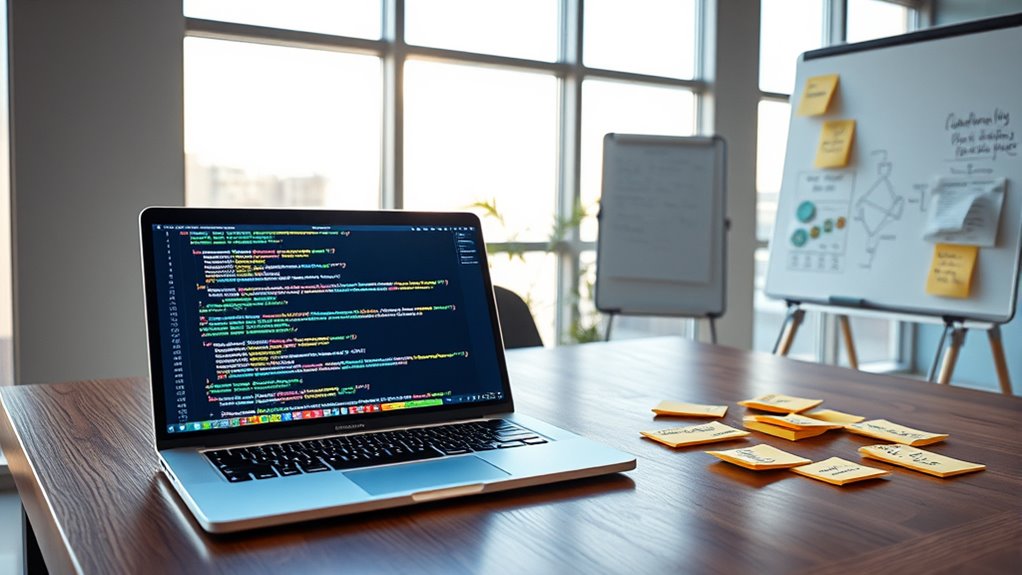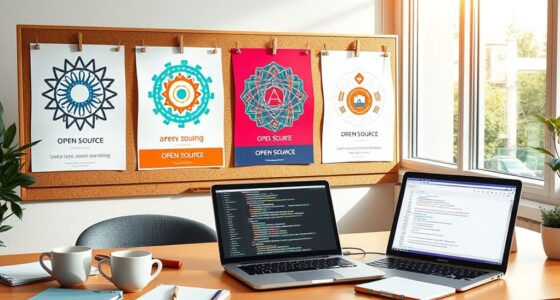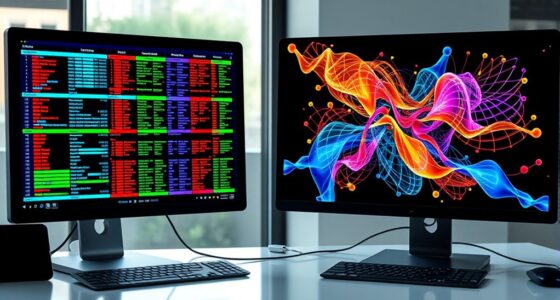To write maintainable software, focus on clean code principles like readability, simplicity, and organization. Use descriptive names, keep functions small, and avoid unnecessary complexity. Refactor regularly to improve clarity without changing how the code works. Structuring your code thoughtfully helps you adapt features easily and troubleshoot faster. Investing in these practices makes future updates smoother and keeps your project scalable. Keep exploring these essential strategies to build robust, long-lasting software.
Key Takeaways
- Follow clear naming conventions and organize code logically to enhance readability and ease future modifications.
- Break down complex functions into smaller, self-contained methods to simplify understanding and maintenance.
- Regularly apply refactoring techniques like extracting methods and renaming variables for cleaner, more understandable code.
- Write concise, focused code with minimal nesting to improve clarity and reduce debugging time.
- Invest in clean code practices to ensure long-term software health, scalability, and easier troubleshooting.

Have you ever wondered why some code is easier to read, maintain, and improve than others? The secret often lies in how well it adheres to clean code principles. At the heart of this is your ability to write clear, organized, and efficient code from the start. One of the most effective ways to achieve this is through refactoring techniques—methods that help you improve your code without changing its external behavior. These techniques focus on enhancing code readability, making it easier for you and others to understand, troubleshoot, and extend the software over time.
Refactoring techniques serve as your toolbox for cleaning up messy code. You begin by identifying sections that are overly complex or cluttered. For example, long functions, duplicated code, or poorly named variables hinder readability and should be broken down or renamed. By applying refactoring strategies like extracting methods, you can turn a cumbersome block of code into smaller, self-contained functions that each perform a single task. This not only makes your code more readable but also simplifies debugging and future modifications. Renaming variables to more descriptive names is another simple yet powerful technique that immediately clarifies the purpose of different parts of your program. These small but consistent improvements cumulatively boost your code’s clarity and maintainability.
Code readability is vital because it directly impacts how easily you can work with your codebase. When your code is well-structured, with clear naming conventions and logical flow, you spend less time deciphering what each part does. This reduces errors, accelerates onboarding for new team members, and streamlines updates and bug fixes. To maximize readability, follow principles like keeping functions short, avoiding deep nesting, and using meaningful comments sparingly to clarify complex logic rather than restating what the code already makes obvious.
Adopting clean code principles means making a conscious effort to write code that’s straightforward and flexible. Regularly applying refactoring techniques keeps your codebase healthy and prevents it from becoming a tangled mess. As you improve your code readability, you’ll find it easier to adapt features, fix issues, or optimize performance, because the underlying structure is clear and logical. Incorporating best practices such as consistent naming conventions and modular design can further enhance your code quality. Ultimately, investing in clean code not only makes your current work smoother but also saves you time and effort in the long run, ensuring your software remains maintainable, scalable, and robust.
Frequently Asked Questions
How Do I Balance Clean Code With Rapid Development?
To balance clean code with rapid development, prioritize refactoring strategies that improve code quality without slowing you down. Use code reviews to catch issues early and maintain standards, ensuring your code remains understandable while progressing quickly. Focus on writing clear, simple code initially, then refactor as needed. This approach helps you keep your code maintainable and adaptable, enabling rapid development without sacrificing long-term readability and ease of maintenance.
What Tools Assist in Writing Clean, Maintainable Code?
You can use static analysis tools and code linters to help write clean, maintainable code. Static analysis scans your code for potential errors and adherence to best practices, catching issues early. Code linters enforce style guidelines and flag problematic patterns, keeping your code consistent. These tools automate quality checks, saving you time and effort while ensuring your code remains understandable and easy to maintain as your project grows.
How Do I Handle Legacy Code That Isn’t Clean?
Handling legacy code is challenging yet rewarding. You should start with a thorough legacy system assessment to identify pain points and risky areas. Then, apply refactoring strategies incrementally, focusing on small, manageable changes to improve readability and maintainability. While the old code may seem formidable, breaking it down into components allows you to modernize effectively. Embrace patience, and over time, you’ll transform your legacy system into a cleaner, more sustainable foundation.
Are There Industry Standards for Naming Conventions?
Yes, there are industry standards for naming conventions. You should prioritize naming consistency and follow standardized practices like using camelCase for variables and functions, PascalCase for classes, and snake_case for file names. Many languages have specific style guides, such as PEP 8 for Python or Java Naming Conventions. Adhering to these standards helps guarantee your code remains clear, maintainable, and easily understandable across your team.
How Can I Train My Team in Clean Coding Practices?
You can train your team in clean coding practices by organizing regular code reviews and pair programming sessions. During code reviews, give constructive feedback on readability and structure. Pair programming encourages knowledge sharing and helps reinforce best practices. Additionally, provide resources on naming conventions and code standards, and promote a culture of continuous learning. These approaches guarantee everyone understands and applies clean code principles effectively across your projects.
Conclusion
By embracing clean code principles, you’ll find your projects become more manageable and enjoyable. It’s funny how small habits—like naming variables well or keeping functions simple—can unexpectedly save you hours later. Sometimes, the best insights come from a simple tweak or a fresh perspective. Keep practicing these principles, and you might just discover that writing maintainable software isn’t as intimidating as it once seemed. After all, clarity often leads to better solutions, even when you least expect it.









